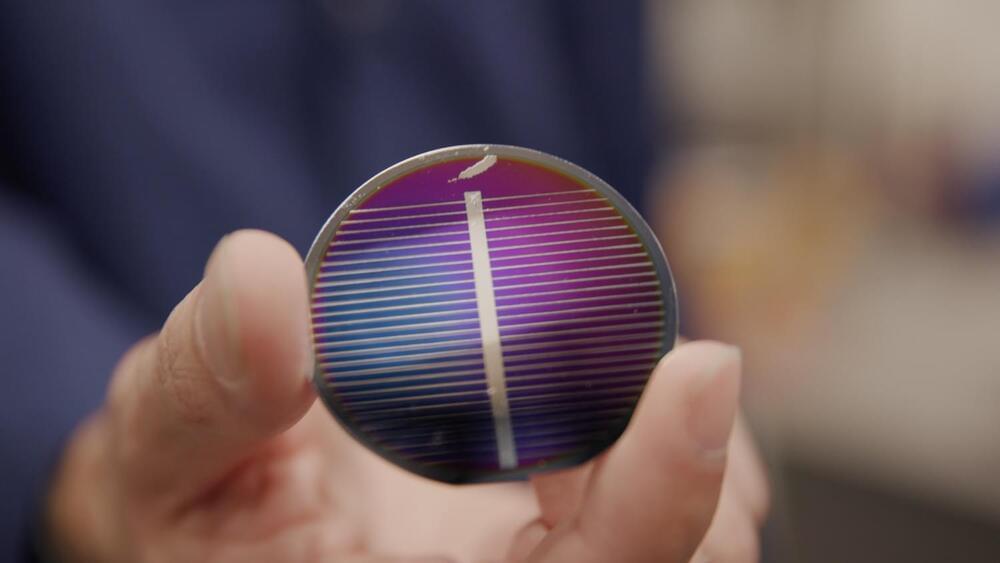A rather mysterious AI startup is claiming to be working on the smartest Robot AI ever made which could even rival humans in some areas. The company is called Sancutary and is a direct competitor to the soon-to-be announced Tesla Bot Optimus. It’s pretty obvious the AI and Robot Race is heating up with more awesome and crazy technology coming out very quickly.
–
TIMESTAMPS:
00:00 The most mysterious AI Company.
02:28 What is Sanctuary?
05:16 Most human Robots.
08:04 Last Words.
–
#robots #ai #agi
Get the latest international news and world events from around the world.
A mind-blowing explanation of the speed of light | Michelle Thaller | Big Think
New videos DAILY: https://bigth.ink.
Join Big Think Edge for exclusive video lessons from top thinkers and doers: https://bigth.ink/Edge.
The only things that travel at the speed of light are photons. Nothing with any mass at all can travel at the speed of light because as it gets closer and closer to the speed of light, its mass increases. And if it were actually traveling at the speed of light, it would have an infinite mass. Light does not experience space or time. It’s not just a speed going through something. All of the universe shifts around this constant, the speed of light. Time and space itself stop when you go that speed.
MICHELLE THALLER: Dr. Michelle Thaller is an astronomer who studies binary stars and the life cycles of stars. She is Assistant Director of Science Communication at NASA. She went to college at Harvard University, completed a post-doctoral research fellowship at the California Institute of Technology (Caltech) in Pasadena, Calif. then started working for the Jet Propulsion Laboratory’s (JPL) Spitzer Space Telescope. After a hugely successful mission, she moved on to NASA’s Goddard Space Flight Center (GSFC), in the Washington D.C. area. In her off-hours often puts on about 30lbs of Elizabethan garb and performs intricate Renaissance dances. For more information, visit.
NASA.
TRANSCRIPT: MICHELLE THALLER: So, Tom, you asked the question, “How does mass increase as you go faster?” And this is really a wonderful part of Einstein’s theories. It actually is also relatively slippery and kind of complicated because to even answer this question at all, we have to ask the rather strange question: “What do you mean by mass? What is your definition of mass?” You may have heard that nothing with mass can possibly go at the speed of light. The only things that travel at the speed of light are photons pure energy, light, the speed of light. Nothing with any mass at all can travel at the speed of light because as it gets closer and closer to the speed of light, its mass increases. And if it were actually traveling at the speed of light, it would have an infinite mass. So think about that. Even if you had a tiny little particle that was, say, billions of times less massive than an electron just a tiny, tiny little piece of mass if for some reason, that tiny thing accelerated to the speed of light, it would have an infinite mass. And that’s a bit of a problem. So let’s talk about this. One of the things that you really have to realize is the speed of light is very, very special. It’s not just simply a speed of something moving through space. As you go faster and faster and closer to the speed of light, time itself begins to slow down. And space begins to contract. As you go close to the speed of light, the entire universe becomes smaller and smaller until it basically just becomes a single point when you’re going at the speed of light. And time, as you go closer to the speed of light, gets slower and slower until basically time is a single point at the speed of light. Light does not experience space or time. It’s not just a speed going through something. All of the universe shifts around this constant, the speed of light. Time and space itself stop when you go that speed. So the reason you can’t accelerate to the speed of light, and the reason we say you have an infinite mass is a little complicated because the idea that mass actually is a measurement of energy. You may remember Einstein’s famous equation, E equals MC squared. Energy equals mass times the speed of light squared. Energy and mass are equivalent. Mass is basically a measurement of how much energy there is in an object. When you’re moving, you have the energy of your motion, too. That’s called kinetic energy, energy of motion. So E equals MC squared, now your mass has not just the stuff that’s in you but also the energy of your motion. And that’s why mass seems to increase as you go faster, and faster, and closer to the speed of light. It’s not that you are actually getting any heavier. The increase in mass is something that’s only observed by people that are watching you go by. If you were on a spaceship going very fast at the speed of light, you don’t notice anything getting heavier. You are on your spaceship. You could jump up and down. You can skip rope. You can do whatever you want. You don’t notice any change at all. But if people try to measure your mass as you go by, they not only are measuring your rest mass — your mass when you were still — but this added energy of this h…For the full transcript, check out https://bigthink.com/videos/speed-of-light
How to make a black hole | NASA’s Michelle Thaller | Big Think
How to make a black hole.
New videos DAILY: https://bigth.ink.
Join Big Think Edge for exclusive video lessons from top thinkers and doers: https://bigth.ink/Edge.
There’s more than one way to make a black hole, says NASA’s Michelle Thaller. They’re not always formed from dead stars. For example, there are teeny tiny black holes all around us, the result of high-energy cosmic rays slamming into our atmosphere with enough force to cram matter together so densely that no light can escape.
CERN is trying to create artificial black holes right now, but don’t worry, it’s not dangerous. Scientists there are attempting to smash two particles together with such intensity that it creates a black hole that would live for just a millionth of a second.
Thaller uses a brilliant analogy involving a rubber sheet, a marble, and an elephant to explain why different black holes have varying densities. Watch and learn!
Bonus fact: If the Earth became a black hole, it would be crushed to the size of a ping-pong ball.
MICHELLE THALLER:

Why Carl Sagan believed that science is a source of spirituality
Yes, the world has some serious problems, but if we did not have problems, we would never be forced to find new solutions. Problems push progress forward. Let’s embrace our ultimate existential challenges and come together to solve them. It is time to forget our differences and think of ourselves only as humans, engaged in a common biological and moral struggle. If the cosmic perspective, and the philosophy of poetic meta-naturalism, or some similar world-view of evolution and emergence, can build a bridge between the reductionist worldview and the religions of the world, then we can be optimistic that a new level of order and functionality will emerge from the current sea of chaos.
Knowledge is enlightenment, knowledge is transcendence, and knowledge is power. The tendency toward disorder described by the second law requires that life acquire knowledge forever, giving us all an individual and collective purpose by creating the constraint that forces us to create. By becoming aware of our emergent purpose, we can live more meaningful lives, in harmony with one another and with the aspirations of nature. You are not a cosmic accident. You are a cosmic imperative.

Scientists Grew Mini Human Guts Inside Mice
The organoids can be used to study the development of diseases and the effects of drugs.
Michael Helmrath, a pediatric surgeon at Cincinnati Children’s Hospital Medical Center, and his colleagues made headlines last week when they revealed trials where they had transplanted balls of human intestinal tissue into mice, according to a report by *Wired* published on Thursday.
After a few weeks, these transplants developed key features of the human immune system, introducing a model that could be used to effectively simulate the human intestinal system.
It’s not the first time researchers at Cincinnati Children’s make such an advancement in organoids (miniature replicas of human organs). In 2010, the institution became the first in the world to create a working intestinal organoid. ## Containing human cells
Since organoids contain human cells and exhibit some of the same structures and functions as real organs, scientists everywhere are using them to study how organs develop, how diseases occur and how drugs work.
“It’s incredibly important that when we are trying to create these platforms for testing drug efficacy and drug side effects in human tissue models that we actually make sure that we are as close to, and as complete as, the tissue in which the drug will work eventually in our human body. So, adding the immune system is an important part of that,” told *Wired* Pradipta Ghosh, director of the Humanoid Center of Research Excellence at the University of California San Diego School, which is engineering human organoids to test drugs. Ghosh was not part of the new study.
Helmrath and his team started with induced pluripotent stem cells, which can turn into any type of body tissue, and fed them a specific molecular cocktail to coax them into transforming into intestinal cells. They ended up with some organoid spheres that the team then carefully transplanted into mice.
What If We Lived in an Ecumenopolis? | Unveiled
A city that’s the size of a planet! Join us, and find out more!
Subscribe for more ► https://wmojo.com/unveiled-subscribe.
In this video, Unveiled takes a closer look at a possible future for life on Earth — planet-sized cities! An Ecumenopolis is a proposed endgame for civilisation, and humanity could be very close to achieving it! But what would life be like inside one? And what would happen after it’s built??
This is Unveiled, giving you incredible answers to extraordinary questions!
Find more amazing videos for your curiosity here:
Parallel Universe Stories to Make You Question Reality — https://youtu.be/1QvShWXCHEQ
Is the Government Hiding Speed of Light Travel? — https://youtu.be/8h1LYN5REmU
0:00 Intro.
This New AI Just BROKE The Film Industry
AI that can make it seem as if you said something you didn’t.
In this How Nifty video, this new AI (artificial intelligence) called Flawless just broke the entire film industry… and more!
Sources:
AI Translation Video: https://www.youtube.com/watch?v=iQ1OPpj8gPA
Mushroom SFX: https://www.instagram.com/p/Ck_XCVPAgPd/
BMW drone + 360 camera: https://www.reddit.com/r/Filmmakers/comments/10kf17b/fpv_dro…ible_shot/
We’ve torn down over 100 cars (Here are Tesla advantages) | Cory Steuben Munro and Associates
The Tesla transformation to a fully integrated design.
Join me and Cory Steuben as he reviews all the different ways Tesla has an advantage over their competitors from manufacturing, the factories, the business model and the team.
Between, Cory, Sandy and the other associates at Munro & Associates they are likely the best in the planet who knows the most about how different cars are made and about the auto industry and the competition in the auto industry.
Cory is the President of Munro & Associates who is the de facto leader in reverse engineering and teardown benchmarking. They tear down all sorts of cars and they know every single part and every single price, the supply chain and what it takes to manufacture these parts.
Cory Steuben on Twitter:@corysteuben.

Blue Alchemist Technology Powers our Lunar Future
To make long-term presence on the Moon viable, we need abundant electrical power. We can make power systems on the Moon directly from materials that exist everywhere on the surface, without special substances brought from Earth. We have pioneered the technology and demonstrated all the steps. Our approach, Blue Alchemist, can scale indefinitely, eliminating power as a constraint anywhere on the Moon.
We start by making regolith simulants that are chemically and mineralogically equivalent to lunar regolith, accounting for representative lunar variability in grain size and bulk chemistry. This ensures our starting material is as realistic as possible, and not just a mixture of lunar-relevant oxides. We have developed and qualified an efficient, scalable, and contactless process for melting and moving molten regolith that is robust to natural variations in regolith properties on the Moon.
Using regolith simulants, our reactor produces iron, silicon, and aluminum through molten regolith electrolysis, in which an electrical current separates those elements from the oxygen to which they are bound. Oxygen for propulsion and life support is a byproduct.
